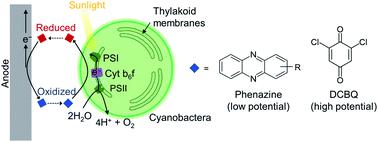当前位置:
X-MOL 学术
›
Chem. Sci.
›
论文详情
Our official English website, www.x-mol.net, welcomes your feedback! (Note: you will need to create a separate account there.)
Phenazines as model low-midpoint potential electron shuttles for photosynthetic bioelectrochemical systems
Chemical Science ( IF 8.4 ) Pub Date : 2021-1-15 , DOI: 10.1039/d0sc05655c Eleanor R Clifford 1 , Robert W Bradley 2 , Laura T Wey 3 , Joshua M Lawrence 3 , Xiaolong Chen 1 , Christopher J Howe 3 , Jenny Z Zhang 1
Chemical Science ( IF 8.4 ) Pub Date : 2021-1-15 , DOI: 10.1039/d0sc05655c Eleanor R Clifford 1 , Robert W Bradley 2 , Laura T Wey 3 , Joshua M Lawrence 3 , Xiaolong Chen 1 , Christopher J Howe 3 , Jenny Z Zhang 1
Affiliation

|
Bioelectrochemical approaches for energy conversion rely on efficient wiring of natural electron transport chains to electrodes. However, state-of-the-art exogenous electron mediators give rise to significant energy losses and, in the case of living systems, long-term cytotoxicity. Here, we explored new selection criteria for exogenous electron mediation by examining phenazines as novel low-midpoint potential molecules for wiring the photosynthetic electron transport chain of the cyanobacterium Synechocystis sp. PCC 6803 to electrodes. We identified pyocyanin (PYO) as an effective cell-permeable phenazine that can harvest electrons from highly reducing points of photosynthesis. PYO-mediated photocurrents were observed to be 4-fold higher than mediator-free systems with an energetic gain of 200 mV compared to the common high-midpoint potential mediator 2,6-dichloro-1,4-benzoquinone (DCBQ). The low-midpoint potential of PYO led to O2 reduction side-reactions, which competed significantly against photocurrent generation; the tuning of mediator concentration was important for outcompeting the side-reactions whilst avoiding acute cytotoxicity. DCBQ-mediated photocurrents were generally much higher but also decayed rapidly and were non-recoverable with fresh mediator addition. This suggests that the cells can acquire DCBQ-resistance over time. In contrast, PYO gave rise to steadier current enhancement despite the co-generation of undesirable reactive oxygen species, and PYO-exposed cells did not develop acquired resistance. Moreover, we demonstrated that the cyanobacteria can be genetically engineered to produce PYO endogenously to improve long-term prospects. Overall, this study established that energetic gains can be achieved via the use of low-potential phenazines in photosynthetic bioelectrochemical systems, and quantifies the factors and trade-offs that determine efficacious mediation in living bioelectrochemical systems.
中文翻译:

吩嗪作为光合生物电化学系统低中点电势电子穿梭模型
能量转换的生物电化学方法依赖于自然电子传输链与电极的有效连接。然而,最先进的外源电子介体会导致显着的能量损失,并且在生命系统的情况下,会导致长期的细胞毒性。在这里,我们通过检查吩嗪作为连接蓝藻集胞藻属光合电子传递链的新型低中点电位分子,探索了外源电子介导的新选择标准。PCC 6803 电极。我们发现绿脓素(PYO)是一种有效的细胞渗透性吩嗪,可以从光合作用的高度还原点获取电子。与常见的高中点电位介体 2,6-二氯-1,4-苯醌 (DCBQ) 相比,PYO 介导的光电流比无介体系统高 4 倍,能量增益为 200 mV。PYO的低中点电位导致O 2还原副反应,这与光电流的产生显着竞争;调节介质浓度对于战胜副反应同时避免急性细胞毒性非常重要。DCBQ 介导的光电流通常要高得多,但衰减也很快,并且添加新鲜介体后不可恢复。这表明细胞随着时间的推移可以获得 DCBQ 抗性。相比之下,尽管同时产生了不需要的活性氧,PYO 仍产生了更稳定的电流增强,并且暴露于 PYO 的细胞没有产生获得性耐药性。此外,我们证明蓝藻可以通过基因工程内源性生产 PYO,以改善长期前景。总体而言,这项研究证实,通过在光合生物电化学系统中使用低电位吩嗪可以实现能量增益,并量化了决定活体生物电化学系统中有效介导的因素和权衡。
更新日期:2021-01-22
中文翻译:

吩嗪作为光合生物电化学系统低中点电势电子穿梭模型
能量转换的生物电化学方法依赖于自然电子传输链与电极的有效连接。然而,最先进的外源电子介体会导致显着的能量损失,并且在生命系统的情况下,会导致长期的细胞毒性。在这里,我们通过检查吩嗪作为连接蓝藻集胞藻属光合电子传递链的新型低中点电位分子,探索了外源电子介导的新选择标准。PCC 6803 电极。我们发现绿脓素(PYO)是一种有效的细胞渗透性吩嗪,可以从光合作用的高度还原点获取电子。与常见的高中点电位介体 2,6-二氯-1,4-苯醌 (DCBQ) 相比,PYO 介导的光电流比无介体系统高 4 倍,能量增益为 200 mV。PYO的低中点电位导致O 2还原副反应,这与光电流的产生显着竞争;调节介质浓度对于战胜副反应同时避免急性细胞毒性非常重要。DCBQ 介导的光电流通常要高得多,但衰减也很快,并且添加新鲜介体后不可恢复。这表明细胞随着时间的推移可以获得 DCBQ 抗性。相比之下,尽管同时产生了不需要的活性氧,PYO 仍产生了更稳定的电流增强,并且暴露于 PYO 的细胞没有产生获得性耐药性。此外,我们证明蓝藻可以通过基因工程内源性生产 PYO,以改善长期前景。总体而言,这项研究证实,通过在光合生物电化学系统中使用低电位吩嗪可以实现能量增益,并量化了决定活体生物电化学系统中有效介导的因素和权衡。


























 京公网安备 11010802027423号
京公网安备 11010802027423号